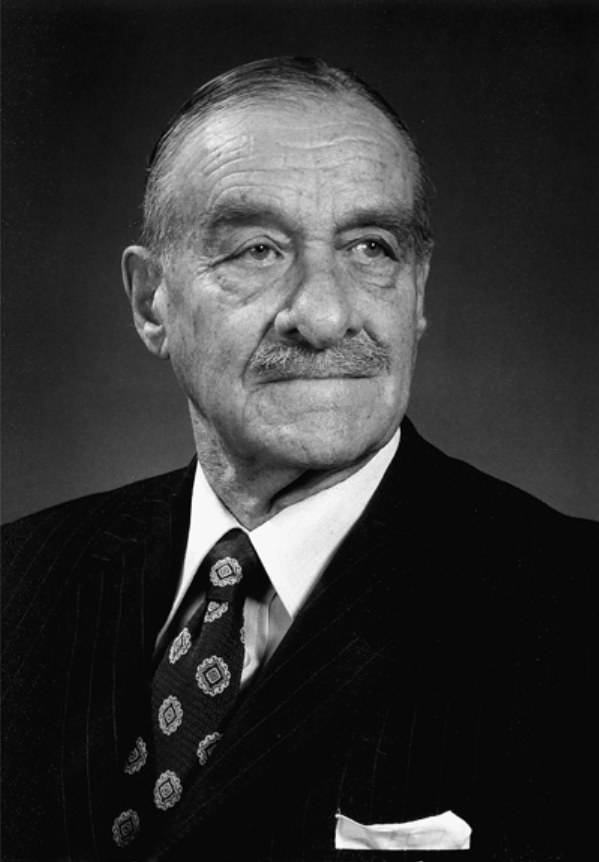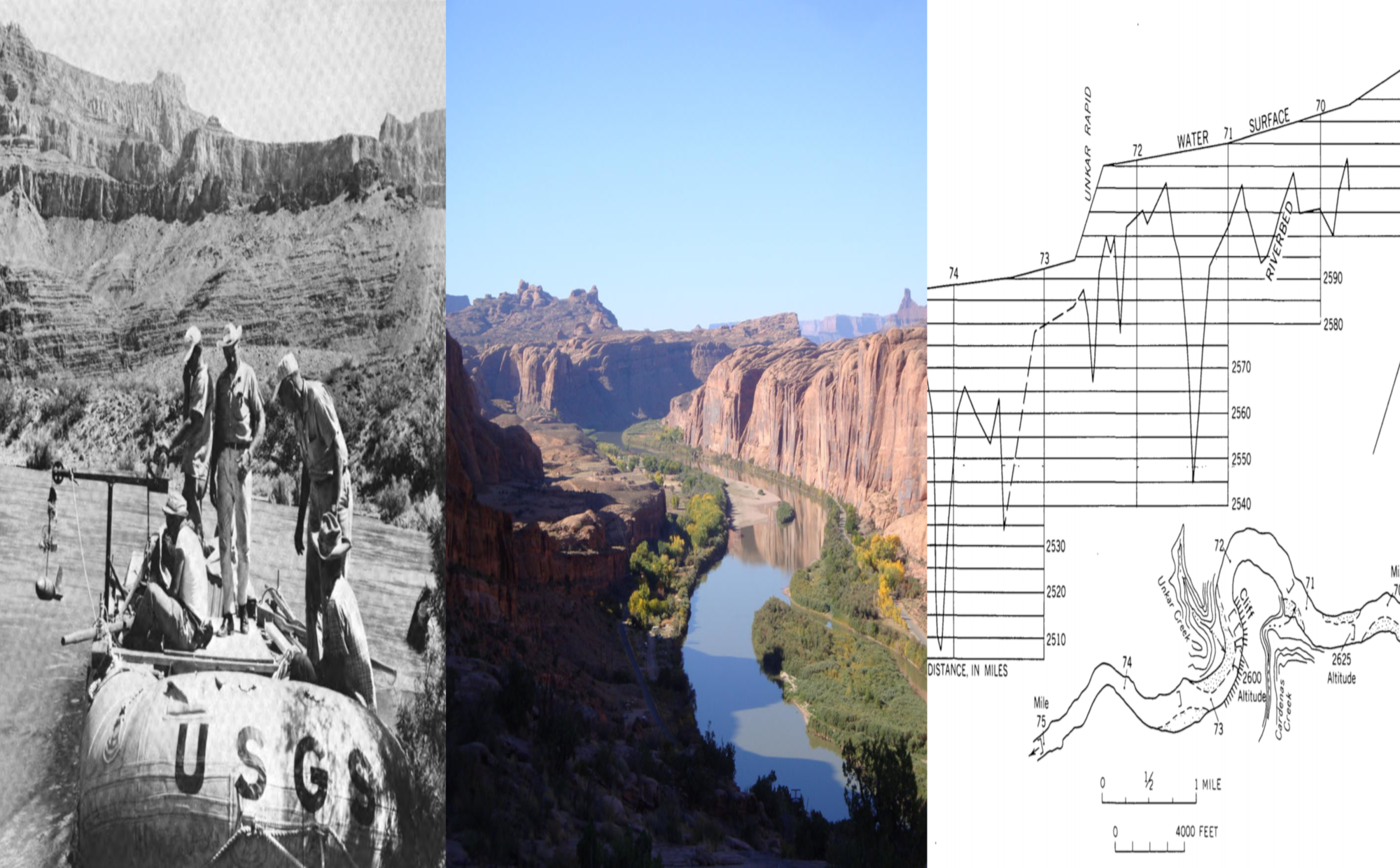Ralph Alger Bagnold (1896-1990) was a physicist, sedimentologist, engineer, explorer and soldier. He received a degree in civil engineering from Cambridge University in 1921, and served in the Royal Corps of Engineers during the interwar period, assisting the Empire by leading geographic expeditions in the deserts of North Africa and the Arabian Peninsula. Towards the end of his life, Bagnold looked back fondly on his days as a soldier, appreciative of the fruitful marriage between Britain’s colonial ambitions and his scientific pursuits.
Bagnold retired from the army in 1935 and published his landmark book, The Physics of Blown Sand and Desert Dunes, in 1939. By then, Bagnold had spent four years working in a hydraulics laboratory at Imperial College, and his interest had begun to shift from sediment transport by wind, to sediment transport by water. At the start of World War II, Bagnold was recalled into military service and stationed in Egypt. Disappointed by how little the British Army understood the local terrain — especially the swathes of desert extending into Italian-controlled Libya — Bagnold took it upon himself to create the Long Range Desert Group, a reconnaissance and raiding unit that travelled the Libyan Desert in Model-Ts. Perhaps it is this phase of Bagnold’s life that is the most well remembered by historians, many of whom credit the Group with providing a decisive advantage to the Allied forces in North Africa.
In 1944, much to his surprise as he considered himself an ‘amateur,’ Bagnold was appointed a Fellow of the Royal Society. By the end of the war, Bagnold had almost entirely reoriented his research to focus on water, publishing a series of papers in the late 1940s and 1950s on the the hydraulics of sediment transport based on experiments utilizing the flumes at Imperial College, as well as his own laboratory in his home in Kent. Unimpressed once again by a lack of knowledge, Bagnold made no attempt to hide his discontent with the state of research in the field of sediment transport. He lamented the kind of practical, problem-solving approach of engineers who made simplistic assumptions and generalizations in service of their disciplinary commitments. In a 1951 paper on the physics of bed load, he wrote:
The engineer, being a busy man, has avoided these difficulties by dealing with and recording only those quantities which are easily measured by conventional methods, regardless of whether they are the simplest for solving the underlying physical problems. He records only the mean values of flow, velocity, bed drag and grain movement over the whole cross-section, in terms of discharge, hydraulic gradient and load. From these quantities, and from a rather alarming number of others, for some of which the physical significance is rather obscure, he is slowly evolving a set of empirical relations.
Ralph Bagnold, “The movement of a cohesionless granular bed by fluid flow over it,” British Journal of Applied Physics 2, no. 2 (1951): 29.
This is not to say that Bagnold dismissed the value of a data-driven, ad-hoc engineering out of hand. On the contrary, later in this paper, he went on to write that the engineer’s datasets and experiments must be complemented with the theoretical work of the physicist who reasons by first principles. The kind of symbiotic relationship that Bagnold considered critical to any meaningful contribution to sediment science materialized in a series of collaborations with Luna Leopold (1915-2006), who invited Bagnold to do research in the US as a consultant for the Water Resources Division of the USGS in 1958.
This collaboration was extremely generative: Leopold needed Bagnold’s expertise in math and physics to develop sound empirical models, and Bagnold benefited from Leopold’s rich datasets and professional networks in the United States. The two jointly published a number of professional papers for the USGS during the 1960s and 70s, and remained close friends even after Bagnold’s health prevented him from embarking on field trips and conducting research with the same vigor. It is unsurprising that when Bagnold was awarded the Penrose Medal by the Geological Society of America in 1970 and the Sorby Medal by the International Association of Sedimentologists in 1978, it was Leopold who presented the awards.
As late as 1988–two years before his death–Bagnold continued to publish scientific papers on sediment transport and fluvial geomorphology. Scientists continue to refer to his studies today, with some applying the results of his experiments in the Libyan Desert to farther, more remote landscapes such as those on Mars, where one may find the “Bagnold Dunes,” named by NASA in his honor.
Publications
2248324
Bagnold
items
1
chicago-fullnote-bibliography
0
default
asc
537
https://www.riversofdata.org/wp-content/plugins/zotpress/
%7B%22status%22%3A%22success%22%2C%22updateneeded%22%3Afalse%2C%22instance%22%3A%22zotpress-ead8c1644623f313ecdc62f313d837f2%22%2C%22meta%22%3A%7B%22request_last%22%3A0%2C%22request_next%22%3A0%2C%22used_cache%22%3Atrue%7D%2C%22data%22%3A%5B%7B%22key%22%3A%22ADM58W2E%22%2C%22library%22%3A%7B%22id%22%3A2248324%7D%2C%22meta%22%3A%7B%22creatorSummary%22%3A%22Leopold%20et%20al.%22%2C%22parsedDate%22%3A%221960%22%2C%22numChildren%22%3A0%7D%2C%22bib%22%3A%22%3Cdiv%20class%3D%5C%22csl-bib-body%5C%22%20style%3D%5C%22line-height%3A%201.35%3B%20padding-left%3A%201em%3B%20text-indent%3A-1em%3B%5C%22%3E%5Cn%20%20%3Cdiv%20class%3D%5C%22csl-entry%5C%22%3ELeopold%2C%20Luna%20B.%2C%20R.%20A.%20Bagnold%2C%20M.%20Gordon%20Wolman%2C%20and%20Lucien%20M.%20Brush.%20%26%23x201C%3BFlow%20Resistance%20in%20Sinuous%20Or%20Irregular%20Channels%2C%26%23x201D%3B%201960.%3C%5C%2Fdiv%3E%5Cn%3C%5C%2Fdiv%3E%22%2C%22data%22%3A%7B%22itemType%22%3A%22journalArticle%22%2C%22title%22%3A%22Flow%20Resistance%20in%20Sinuous%20Or%20Irregular%20Channels%22%2C%22creators%22%3A%5B%7B%22creatorType%22%3A%22author%22%2C%22firstName%22%3A%22Luna%20B.%22%2C%22lastName%22%3A%22Leopold%22%7D%2C%7B%22creatorType%22%3A%22author%22%2C%22firstName%22%3A%22R.%20A.%22%2C%22lastName%22%3A%22Bagnold%22%7D%2C%7B%22creatorType%22%3A%22author%22%2C%22firstName%22%3A%22M.%20Gordon%22%2C%22lastName%22%3A%22Wolman%22%7D%2C%7B%22creatorType%22%3A%22author%22%2C%22firstName%22%3A%22Lucien%20M.%22%2C%22lastName%22%3A%22Brush%22%7D%5D%2C%22abstractNote%22%3A%22%22%2C%22date%22%3A%221960%22%2C%22language%22%3A%22en%22%2C%22DOI%22%3A%22%22%2C%22ISSN%22%3A%22%22%2C%22url%22%3A%22%22%2C%22collections%22%3A%5B%5D%2C%22dateModified%22%3A%222020-06-25T16%3A04%3A26Z%22%7D%7D%2C%7B%22key%22%3A%22VZW6PG2M%22%2C%22library%22%3A%7B%22id%22%3A2248324%7D%2C%22meta%22%3A%7B%22creatorSummary%22%3A%22Bagnold%22%2C%22parsedDate%22%3A%221941%22%2C%22numChildren%22%3A1%7D%2C%22bib%22%3A%22%3Cdiv%20class%3D%5C%22csl-bib-body%5C%22%20style%3D%5C%22line-height%3A%201.35%3B%20padding-left%3A%201em%3B%20text-indent%3A-1em%3B%5C%22%3E%5Cn%20%20%3Cdiv%20class%3D%5C%22csl-entry%5C%22%3EBagnold%2C%20Ralph%20Alger.%20%3Ci%3EThe%20Physics%20of%20Blown%20Sand%20and%20Desert%20Dunes%3C%5C%2Fi%3E.%20London%26%23x202F%3B%3B%20New%20York%26%23x202F%3B%3A%20Methuen%20%26amp%3B%20Co.%26%23x202F%3B%3A%20William%20Morrow%2C%201941.%20%3Ca%20href%3D%27https%3A%5C%2F%5C%2Ftrove.nla.gov.au%5C%2Fwork%5C%2F10575959%27%3Ehttps%3A%5C%2F%5C%2Ftrove.nla.gov.au%5C%2Fwork%5C%2F10575959%3C%5C%2Fa%3E.%3C%5C%2Fdiv%3E%5Cn%3C%5C%2Fdiv%3E%22%2C%22data%22%3A%7B%22itemType%22%3A%22book%22%2C%22title%22%3A%22The%20physics%20of%20blown%20sand%20and%20desert%20dunes%22%2C%22creators%22%3A%5B%7B%22creatorType%22%3A%22author%22%2C%22firstName%22%3A%22Ralph%20Alger%22%2C%22lastName%22%3A%22Bagnold%22%7D%5D%2C%22abstractNote%22%3A%22Winds.%3B%20Sand%20dunes.%3B%20Sand-dunes.%5Cn%5CnTHE%20NATURE%20OF%20THE%20PROBLEM%20THIS%20book%20results%20from%20an%20attempt%20to%20explain%20on%20a%20basis%20of%20experimental%20physics%20some%20of%20the%20many%20strange%20phenomena%20produced%20by%20the%20natural%20movement%20of%20sand%20over%20the%20dry%20land%20of%20the%20Earth.%20The%20subject%20is%20but%20one%20aspect%20of%20a%20far%20wider%20problem%20which%20is%20still%20very%20imperfectly%20grasped-the%20transport%20of%20solid%20particles%20of%20any%20kind%20by%20fluids%20in%20general.%20Here%20the%20difficulty%20has%20been%2C%20and%20still%20is%2C%20that%20no%20one%20branch%20of%20science%20has%20attempted%20to%20deal%20with%20the%20problem%20as%20a%20whole%2C%20or%20to%20co-ordinate%20the%20vast%20amount%20of%20piecemeal%20work%20by%20students%20of%20different%20outlook%20in%20many%20unrelated%20fields.%20The%20carriage%20of%20silt%20by%20rivers%20has%20received%20a%20great%20deal%20of%20attention%20from%20engineers.%20But%20owing%20to%20the%20difficulties%20of%20direct%20measurement%2C%20to%20the%20expense%20and%20labour%20of%20conducting%20full-scale%20experiments%2C%20and%20to%20a%20failure%20to%20find%20agreement%20as%20to%20the%20basic%20quantities%20upon%20which%20a%20theoretical%20edifice%20may%20be%20built%2C%20the%20published%20results%20are%20far%20from%20satisfactory.%20Little%20has%20emerged%20except%20empirical%20formulae%3B%20and%20these%20are%20rarely%20capable%20of%20reliable%20application%20to%20conditions%20other%20than%20those%20under%20which%20they%20were%20evolved.%20The%20drifting%20of%20snow%20is%20of%20direct%20interest%20to%20transport%20authorities%20in%20many%20countries%2C%20to%20meteorologists%20engaged%20in%20the%20study%20of%20rainfall%2C%20to%20ski-runners%20and%20to%20mountaineers.%20Yet%20no%20means%20has%20been%20found%20whereby%20the%20precipitation%20can%20be%20gauged%2C%20or%20the%20rate%20of%20drift%20related%20to%20the%20strength%20of%20the%20wind.%22%2C%22date%22%3A%221941%22%2C%22language%22%3A%22English%22%2C%22ISBN%22%3A%22%22%2C%22url%22%3A%22https%3A%5C%2F%5C%2Ftrove.nla.gov.au%5C%2Fwork%5C%2F10575959%22%2C%22collections%22%3A%5B%5D%2C%22dateModified%22%3A%222020-06-25T15%3A51%3A41Z%22%7D%7D%2C%7B%22key%22%3A%22HEAIHJJW%22%2C%22library%22%3A%7B%22id%22%3A2248324%7D%2C%22meta%22%3A%7B%22creatorSummary%22%3A%22Bagnold%20and%20Barndorff-Nielsen%22%2C%22parsedDate%22%3A%221980%22%2C%22numChildren%22%3A0%7D%2C%22bib%22%3A%22%3Cdiv%20class%3D%5C%22csl-bib-body%5C%22%20style%3D%5C%22line-height%3A%201.35%3B%20padding-left%3A%201em%3B%20text-indent%3A-1em%3B%5C%22%3E%5Cn%20%20%3Cdiv%20class%3D%5C%22csl-entry%5C%22%3EBagnold%2C%20R.%20A.%2C%20and%20O.%20Barndorff-Nielsen.%20%26%23x201C%3BThe%20Pattern%20of%20Natural%20Size%20Distributions.%26%23x201D%3B%20%3Ci%3ESedimentology%3C%5C%2Fi%3E%2027%2C%20no.%202%20%281980%29%3A%20199%26%23x2013%3B207.%20%3Ca%20href%3D%27https%3A%5C%2F%5C%2Fdoi.org%5C%2F10.1111%5C%2Fj.1365-3091.1980.tb01170.x%27%3Ehttps%3A%5C%2F%5C%2Fdoi.org%5C%2F10.1111%5C%2Fj.1365-3091.1980.tb01170.x%3C%5C%2Fa%3E.%3C%5C%2Fdiv%3E%5Cn%3C%5C%2Fdiv%3E%22%2C%22data%22%3A%7B%22itemType%22%3A%22journalArticle%22%2C%22title%22%3A%22The%20pattern%20of%20natural%20size%20distributions%22%2C%22creators%22%3A%5B%7B%22creatorType%22%3A%22author%22%2C%22firstName%22%3A%22R.%20A.%22%2C%22lastName%22%3A%22Bagnold%22%7D%2C%7B%22creatorType%22%3A%22author%22%2C%22firstName%22%3A%22O.%22%2C%22lastName%22%3A%22Barndorff-Nielsen%22%7D%5D%2C%22abstractNote%22%3A%22The%20pattern%20of%20empirical%20distributions%2C%20in%20particular%20size%20distributions%2C%20is%20often%20best%20brought%20out%20by%20drawing%20a%20log-histogram.%20The%20Gaussian%20or%20%5Cu2018normal%5Cu2019%20distribution%20furnishes%20a%20description%20of%20the%20empirical%20distribution%20if%20the%20log-histogram%20approximates%20to%20a%20parabola.%20In%20many%20cases%2C%20however%2C%20the%20log-histogram%20is%20far%20from%20parabolic%20but%20may%20be%20closely%20approximated%20by%20a%20hyperbola.%20It%20is%20therefore%20natural%20to%20consider%20those%20theoretical%20probability%20distributions%20for%20which%20the%20graph%20of%20the%20logprobability%20%28density%29%20function%20is%20a%20hyperbola.%20The%20theory%20and%20applicability%20of%20such%20hyperbolic%20disfributions%20have%20been%20the%20subject%20of%20a%20number%20of%20recent%20investigations%20and%20it%20is%20the%20purpose%20of%20the%20present%20paper%20to%20summarize%20these%20developments%2C%20with%20regard%20to%20the%20interest%20they%20may%20have%20to%20sedimentologists.%20A%20precise%20description%20of%20the%20hyperbolic%20distributions%20is%20given%20and%20their%20wide%20applicability%20is%20indicated.%20Methods%20for%20fitting%20these%20distributions%20to%20data%20are%20discussed%20and%20a%20number%20of%20sedimentological%20examples%20are%20presented.%20Furthermore%2C%20the%20question%20of%20finding%20dynamical%20explanations%20for%20the%20occurrence%20of%20the%20hyperbolic%20shape%20is%20considered%20from%20various%20points%20of%20view.%22%2C%22date%22%3A%2204%5C%2F1980%22%2C%22language%22%3A%22en%22%2C%22DOI%22%3A%2210.1111%5C%2Fj.1365-3091.1980.tb01170.x%22%2C%22ISSN%22%3A%220037-0746%2C%201365-3091%22%2C%22url%22%3A%22http%3A%5C%2F%5C%2Fdoi.wiley.com%5C%2F10.1111%5C%2Fj.1365-3091.1980.tb01170.x%22%2C%22collections%22%3A%5B%5D%2C%22dateModified%22%3A%222020-06-25T15%3A51%3A36Z%22%7D%7D%2C%7B%22key%22%3A%224XE2EZ49%22%2C%22library%22%3A%7B%22id%22%3A2248324%7D%2C%22meta%22%3A%7B%22creatorSummary%22%3A%22Bagnold%22%2C%22parsedDate%22%3A%221935%22%2C%22numChildren%22%3A0%7D%2C%22bib%22%3A%22%3Cdiv%20class%3D%5C%22csl-bib-body%5C%22%20style%3D%5C%22line-height%3A%201.35%3B%20padding-left%3A%201em%3B%20text-indent%3A-1em%3B%5C%22%3E%5Cn%20%20%3Cdiv%20class%3D%5C%22csl-entry%5C%22%3EBagnold%2C%20R.%20A.%20%26%23x201C%3BThe%20Movement%20of%20Desert%20Sand.%26%23x201D%3B%20%3Ci%3EThe%20Geographical%20Journal%3C%5C%2Fi%3E%2085%2C%20no.%204%20%281935%29%3A%20342.%20%3Ca%20href%3D%27https%3A%5C%2F%5C%2Fdoi.org%5C%2F10.2307%5C%2F1785593%27%3Ehttps%3A%5C%2F%5C%2Fdoi.org%5C%2F10.2307%5C%2F1785593%3C%5C%2Fa%3E.%3C%5C%2Fdiv%3E%5Cn%3C%5C%2Fdiv%3E%22%2C%22data%22%3A%7B%22itemType%22%3A%22journalArticle%22%2C%22title%22%3A%22The%20Movement%20of%20Desert%20Sand%22%2C%22creators%22%3A%5B%7B%22creatorType%22%3A%22author%22%2C%22firstName%22%3A%22R.%20A.%22%2C%22lastName%22%3A%22Bagnold%22%7D%5D%2C%22abstractNote%22%3A%22%22%2C%22date%22%3A%2204%5C%2F1935%22%2C%22language%22%3A%22en%22%2C%22DOI%22%3A%2210.2307%5C%2F1785593%22%2C%22ISSN%22%3A%2200167398%22%2C%22url%22%3A%22https%3A%5C%2F%5C%2Fwww.jstor.org%5C%2Fstable%5C%2F1785593%3Forigin%3Dcrossref%22%2C%22collections%22%3A%5B%5D%2C%22dateModified%22%3A%222020-06-25T15%3A51%3A33Z%22%7D%7D%2C%7B%22key%22%3A%22YYMQJG85%22%2C%22library%22%3A%7B%22id%22%3A2248324%7D%2C%22meta%22%3A%7B%22creatorSummary%22%3A%22Bagnold%22%2C%22parsedDate%22%3A%221951%22%2C%22numChildren%22%3A0%7D%2C%22bib%22%3A%22%3Cdiv%20class%3D%5C%22csl-bib-body%5C%22%20style%3D%5C%22line-height%3A%201.35%3B%20padding-left%3A%201em%3B%20text-indent%3A-1em%3B%5C%22%3E%5Cn%20%20%3Cdiv%20class%3D%5C%22csl-entry%5C%22%3EBagnold%2C%20R.%20A.%20%26%23x201C%3BThe%20Movement%20of%20a%20Cohesionless%20Granular%20Bed%20by%20Fluid%20Flow%20over%20It.%26%23x201D%3B%20%3Ci%3EBritish%20Journal%20of%20Applied%20Physics%3C%5C%2Fi%3E%202%2C%20no.%202%20%281951%29%3A%2029.%20%3Ca%20href%3D%27https%3A%5C%2F%5C%2Fdoi.org%5C%2F10.1088%5C%2F0508-3443%5C%2F2%5C%2F2%5C%2F301%27%3Ehttps%3A%5C%2F%5C%2Fdoi.org%5C%2F10.1088%5C%2F0508-3443%5C%2F2%5C%2F2%5C%2F301%3C%5C%2Fa%3E.%3C%5C%2Fdiv%3E%5Cn%3C%5C%2Fdiv%3E%22%2C%22data%22%3A%7B%22itemType%22%3A%22journalArticle%22%2C%22title%22%3A%22The%20movement%20of%20a%20cohesionless%20granular%20bed%20by%20fluid%20flow%20over%20it%22%2C%22creators%22%3A%5B%7B%22creatorType%22%3A%22author%22%2C%22firstName%22%3A%22R.%20A.%22%2C%22lastName%22%3A%22Bagnold%22%7D%5D%2C%22abstractNote%22%3A%22Our%20knowledge%20of%20the%20basic%20principles%20underlying%20%5C%22Loose%20boundary%20hydraulics%5C%22%20is%20weak%2C%20owing%20mainly%20to%20the%20difficulties%20of%20observation%20and%20measurement.%20The%20corresponding%20case%20of%20grains%20moved%20by%20wind%20presents%20fewer%20experimental%20difficulties%20and%20is%20found%20to%20be%20fairly%20simple.%20But%20the%20behaviour%20of%20the%20grains%20is%20here%20so%20different%20that%20the%20principles%20have%20not%20been%20found%20easy%20to%20apply%20to%20the%20water%20case.%20These%20differences%20are%20examined%2C%20and%20an%20attempt%20is%20made%20to%20explain%20them%20in%20terms%20of%20the%20relative%20degree%20to%20which%20a%20free%20grain%20can%20penetrate%20through%20the%20fluid%20under%20its%20own%20initial%20momentum.%20The%20penetration%20is%20defined%2C%20and%20its%20effects%20are%20applied%20to%20various%20grain-fluid%20phenomena.%22%2C%22date%22%3A%221951%22%2C%22language%22%3A%22en%22%2C%22DOI%22%3A%2210.1088%5C%2F0508-3443%5C%2F2%5C%2F2%5C%2F301%22%2C%22ISSN%22%3A%220508-3443%22%2C%22url%22%3A%22http%3A%5C%2F%5C%2Fstacks.iop.org%5C%2F0508-3443%5C%2F2%5C%2Fi%3D2%5C%2Fa%3D301%22%2C%22collections%22%3A%5B%5D%2C%22dateModified%22%3A%222020-06-25T15%3A51%3A29Z%22%7D%7D%5D%7D
Leopold, Luna B., R. A. Bagnold, M. Gordon Wolman, and Lucien M. Brush. “Flow Resistance in Sinuous Or Irregular Channels,” 1960.
Bagnold, Ralph Alger.
The Physics of Blown Sand and Desert Dunes. London ; New York : Methuen & Co. : William Morrow, 1941.
https://trove.nla.gov.au/work/10575959.
Bagnold, R. A., and O. Barndorff-Nielsen. “The Pattern of Natural Size Distributions.”
Sedimentology 27, no. 2 (1980): 199–207.
https://doi.org/10.1111/j.1365-3091.1980.tb01170.x.
Bagnold, R. A. “The Movement of Desert Sand.”
The Geographical Journal 85, no. 4 (1935): 342.
https://doi.org/10.2307/1785593.
Bagnold, R. A. “The Movement of a Cohesionless Granular Bed by Fluid Flow over It.”
British Journal of Applied Physics 2, no. 2 (1951): 29.
https://doi.org/10.1088/0508-3443/2/2/301.

